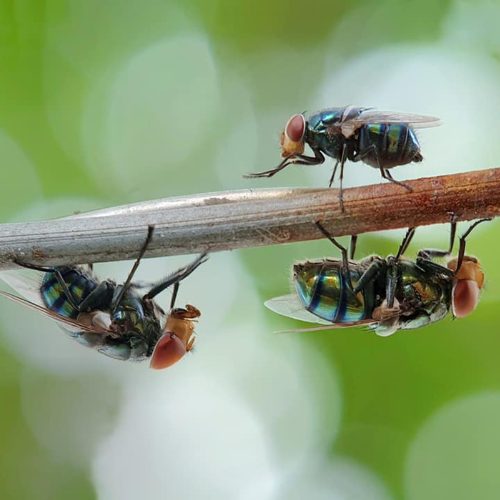
13 Dec Managing Flies Effective Strategies
Fly Control Essentials
Flies, often dismissed as mere nuisances, actually play a significant role in public health, especially in managing flies for effective pest management. Their habits, life cycle, and potential dangers merit closer examination. Common in households, flies are known for their rapid breeding and attraction to various food sources, making kitchens, waste bins, and food storage areas hotspots for infestations. The health risks associated with flies are substantial, as they are carriers of numerous pathogens, spreading diseases like salmonella and E. coli by landing on and contaminating food and surfaces.
Fruit flies, for instance, are drawn to overripe fruits and fermenting items.
Houseflies, in contrast are attracted to a variety of organic materials. Effective fly control begins with stringent hygiene practices. Ensuring regular garbage disposal and keeping food covered are essential steps. Installing screens on windows and doors can greatly minimize the entry of flies into homes.
Beyond cleanliness, managing flies involves the use of repellents, both chemical and natural, which is crucial in controlling fly populations. Tools such as fly traps, insecticides, and electric zappers are widely used for managing flies. Nonetheless, natural alternatives like essential oil sprays or vinegar traps are increasingly popular for managing flies. Identifying the specific type of fly infestation is vital for choosing the most effective control method in managing flies. For severe or persistent infestations, professional pest control services can provide targeted, customized solutions for managing flies.
South Florida’s climate is a perfect habitat for various fly species, each with unique characteristics and behaviors. Understanding these species is key to effective control and management. Here we explore the top five fly species prevalent in South Florida, delving into their biology and behaviors.
Biology and Behavior
House Fly (Musca domestica): The most common fly species in homes, the House Fly measures about 1/4 inch in length. They are gray in color and have four dark stripes on their thorax. These flies are known carriers of diseases like food poisoning and dysentery. They breed in moist, decaying organic material, including garbage and animal waste.
Fruit Fly (Drosophila melanogaster): Small and reddish-brown, Fruit Flies are common in kitchens and where fruit is present. They breed in fermenting fruits and vegetables, making them a frequent nuisance in homes. Their life cycle is incredibly fast, allowing populations to explode in just a few days.
Horse Fly (Tabanus spp.): Larger than most flies, Horse Flies are notorious for their painful bite. They are typically found near livestock or in rural areas. These flies feed on blood, with females being the primary biters. They breed in moist soil near bodies of water.
Blue Bottle Fly (Calliphora vomitoria): Recognizable by their metallic blue color, these flies are larger than houseflies. They are attracted to decaying meat and are known for their loud buzzing. Blue Bottle Flies lay their eggs in decaying meat, garbage, and animal carcasses.
Drain Fly (Clogmia albipunctata): Small and moth-like, Drain Flies breed in the sludge of drains and sewers. They are common in bathrooms and kitchens, near sources of standing water. While harmless, their presence indicates a need for better sanitation and drain maintenance.
Tips & Tricks
Active Cleaning and Sanitation:
- Regularly clean and disinfect your home, with a focus on areas where flies tend to gather, such as kitchens and dining areas.
- Dispose of garbage promptly and use trash cans with tight-fitting lids to deny flies access.
- Clean pet litter boxes and outdoor areas where pet waste accumulates.
- Keep drains clear and unclogged to prevent fly breeding.
Efficient Waste Management:
- Seal organic waste, such as food scraps and pet waste, in airtight bags or containers before disposing of them.
- Consider using compost bins with secure lids for organic waste disposal.
- Regularly empty and clean trash cans and recycling bins to remove attractants.
Strategically Employ Screens and Seals:
- Install fine mesh screens on windows and doors to block flies from entering your home.
- Seal any gaps, cracks, or holes in walls, doors, and window frames to close off entry points.
Utilize Fly Traps and Zappers:
- Place fly traps in areas with high fly activity, like near windows or fruit baskets.
- Electric fly zappers can effectively target outdoor fly congregations.
Harness Natural Repellents and Home Remedies:
- Prepare natural fly repellent sprays by mixing essential oils like citronella, lavender, or eucalyptus with water.
- Set up vinegar traps by positioning a bowl with apple cider vinegar and a few drops of dish soap to attract and capture flies.
Mindful Food Storage:
- Safeguard food in airtight containers or resealable bags to prevent fly access.
- Keep fruit and vegetables in the refrigerator or utilize fruit bowls with mesh covers.
Consistent Pet Care:
- Ensure pet hygiene by regularly grooming and bathing pets to reduce odors that attract flies.
- Frequently clean pet bedding and litter boxes to eliminate potential breeding sites.
Professional Pest Control:
In managing flies, consult a professional pest control service. Pest control experts will conduct thorough inspections, identify breeding sources, and apply targeted treatments to eliminate flies


No Comments